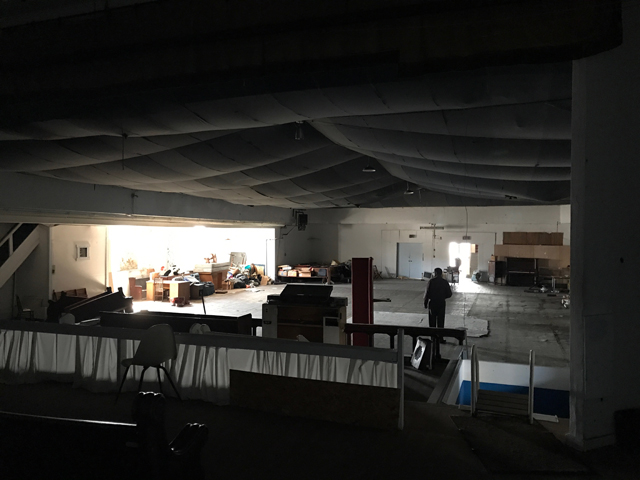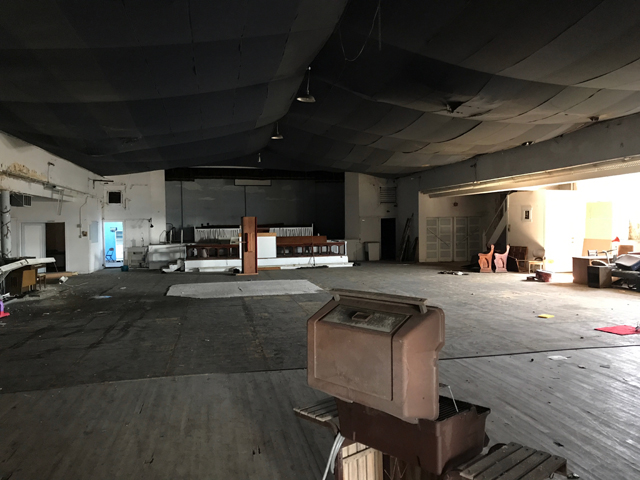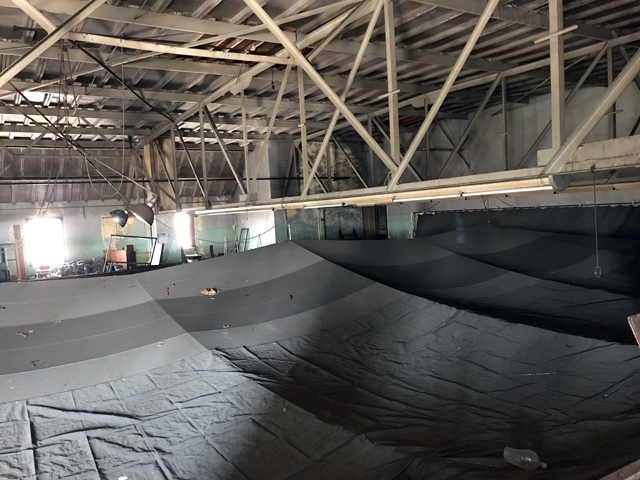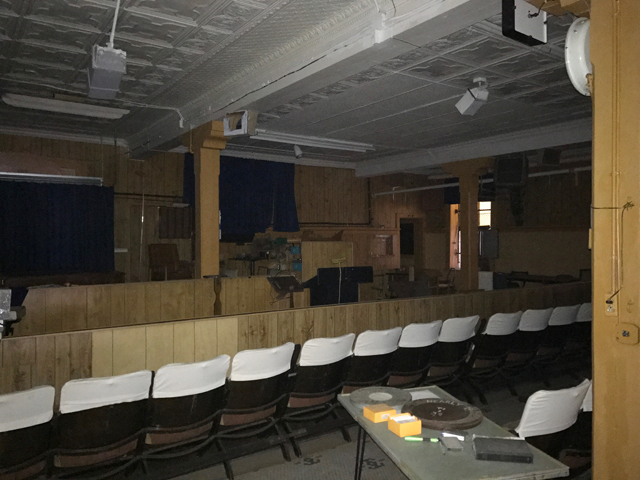(NOTE: This building was listed for sale again by the City of Milwaukee in June 2024. Here is the listing.)
These days Turner Hall means a very specific building on 4th Street between State and Highland. But a century ago, you’d have had to be more specific, because there were at least two other Turner halls.
One on National Avenue on the South Side fell to make way for the expressway. But the North Side Turner hall – the Bahn Frei Turner Hall – still stands at 1118-26 W. North Ave.
A publication commemorating the 100th anniversary of the Milwaukee Turners noted that "for a decade or two there were as many as eight Turner Halls in the city," without naming them or their locations.
Currently vacant and owned by the City of Milwaukee, the building’s layout is quite similar to the Downtown Turner Hall’s and in recent decades housed a series of churches.
At one point there were apparently three congregations sharing the building, which is much larger than it appears from the street.
Even larger is the building’s history, which encompasses the German Turnverein movement, the boxing and wrestling scenes and jazz and blues music, too.
Who were the Turners?
Founded in German in 1811 by revolutionary Friedrich Ludwig Jahn, the Turners began as a political organization with a goal of ousting Napoleon from Prussia and unifying the divided German states.
After the failed 1848 revolution, more than a half-million exiled Germans fled to places like New York, Cincinnati and Milwaukee, where they founded German colonies with German language newspapers, German theater and more.

They also brought their organization with them and Cincinnati had a Turnverein already by 1848.
Supporters of equality, women’s suffrage and freedom for all, they were also keen on keeping fit, which is why Turnvereins had gyms and gymnastic teams. In fact, the name Turners comes from the German word for gymnastics.

"The Turner Halls became the symbols of progress," wrote Theodore Mueller in that 100th anniversary booklet, "where every dreamer, every social and political exponent could express his thoughts for better or worse. Good comradeship and good cheer was always encouraged for the sound thinking and well meaning."
Who were the Bahn Frei Turners?
Milwaukee, like St. Louis and Chicago – and surely other cities – had a group of Bahn Frei Turners, too, who set up shop in the heart of a German community on the North Side. Milwaukee’s group was organized in 1884.
Bahn Frei, which means, literally, "free path" – meaning "clear the path," like "look out" or "get out of the way" – was often etched into the swords of Turners who fought in the U.S. Civil War. It was also the name of a Turners magazine.

According to UWM history professor Aims McGuinness, while the West Side Turners (Downtown) were populated by the German social elite, the Bahn Frei, or North Side, Turners were heavily working class. As such, it was the more progressive of the groups.
The Bahn Frei Turner Hall – built in 1892 – on 12th and North was Victor Berger’s home turf.

Victor Berger's home turf
Berger was the founder of the American Socialist Party and was elected to the United States Congress in 1910. During the heat of World War I, Berger was indicted under the Espionage Act. But despite that, Milwaukee sent him back to Congress, which refused to allow him to take his seat, which was declared vacant.
A special election was held to fill the vacant seat and again Milwaukee voted for Berger, who was, again, denied his seat. A Republican candidate later won the seat in a general election, but Berger won it back three times more in the 1920s.

The box office window.
Berger’s fiery speeches at the North Side Turner Hall are referenced in the records of a Special congressional committee that investigated Berger:
"‘I would fight for no kaiser, no king and no president: I would take up arms for no nationalist, capitalist or feudal reason,’ said Victor L. Berger, candidate for Congress, in the opening meeting of the Socialist campaign last night in the Bahn Frei Turn Hall, Twelfth St. and North Ave."

The ballroom seen from the stage.
There are stories, too, of folks telephoning details of Berger’s speeches to a speaker at another venue across town, who would then offer rebuttals from the stage, which were phoned back to the Bahn Frei.
The end of the free path
Interestingly, it appears that the Turners who built the sprawling hall – which was used for dances, meetings and social events – couldn’t likely afford to keep it up. In 1898 is was purchased by Chicago’s Schoenhofen Brewing Co. at auction for $1 and rented back to the Turners.
That also explains why the hall was rented to the Friends of the New Germany movement in 1934, a National Socialist (Nazi) group that surely sat in direct opposition to the Turners’ progressive beliefs.

The gym.
In fact, it seems that the Bahn Frei Turnverein had ceased to exist by the 1930s. The group’s records, held at UWM’s Golda Meir Library, run only through 1929.
A more casual group appears to have continued under the Bahn Frei name – which remained attached to the building for decades – but they were focused more on games like skat and bowling than politics.
In fact, it was sport and gaming that became the main focus of the club, which held gymnastics events, as well as boxing and wrestling matches up in the main ballroom – including top names, like South Milwaukee’s The Crusher and even boxing champ Jack Dempsey, who didn’t fight there, but did appear as a celebrity referee – for the first half of the 20th century.

(Architectural plans dated 1934.)
It was a game that landed Bahn Frei in the news in the late 1930s, when Wisconsin’s cinema theater managers, concerned that bingo games were stealing their clientele, argued that organized bingo violated the state’s anti-gaming laws.
One of the theater operators’ main targets were the bingo games held at the Bahn Frei hall, according to Eric Fure-Slocum’s book, "Contesting the Postwar City: Working-Class and Growth Politics in 1940s MIlwaukee."
"In addition to key targets such as the Bahn Frei games, (theater operator consortium president Charles W.) Trampe tried to stop games in locations such as the American Luther Association Hall, an organization with ties to Conservative Lutheran synods," he writes.
"As one observer noted, ‘Trampe was wrought up because the hall was being packed almost nightly with bingo fans, who were, of course, neglecting their double features."
When the Wisconsin Supreme Court sided with the cinema men, bingo players at Bahn Frei booed the decision, says Fure-Slocum.
Luckily, the fights continued in the building, which over the years had a variety of tenants.

A fire and a new life
In the 1930s – when Edward Zrimsek owned the building and ran, first, a soft drink parlor and later a tavern there – a fire led the Turner gymnasts to relocate their practice and classes to the North Avenue Auditorium near 32nd and North, and their meetings to the Swiss Club on 24th and Vliet, according to Maralyn Wellauer-Lenius’ book "Swiss in Greater Milwaukee."
Architects were hired to draw up new plans for portions of the building affected by the fire and at this time there were Zrimsek’s tavern, the offices of an insurance company and the Bahn Frei Mutual Building and Loan Association, and the Bahn-Frei Hall operating in the building. City permits note that the complex also had some residential component.
Indeed one drawing shows an apartment on the first floor, behind the tavern space, suggesting it was a tavernkeeper’s apartment.
In the 1940s, the real estate office was replaced with meeting hall/party room and a contractor had moved into the old building and loan office.
By 1950, the State Musicians’ Union occupied space in the building and the following year a pool hall chalked up its cues in the recessed, former gym area in the back of the building.
Ron-De-Voo with Lady Day
It was this era that is perhaps the most exciting, because it is the era when the Ron-De-Voo Ballroom opened in what architectural plans from the 1930s suggest had operated as a "palm garden, cafe and dance hall."
The Ron-De-Voo opened sometime in the 1940s -- this we know because the Journal wrote about "quiet little Italian" bandleader Sammy Madden, whose orchestra played there nightly in 1949 – but it was in 1953, that Lady Day – Billie Holiday – performed for four nights in August.
There are two old, torn-up pianos in the building today and I gazed long and hard at each, wondering if one of them was the piano Holiday leaned on as she crooned those summer nights more than 60 years ago.
In 1954, the Ron-De-Voo hosted a 90th Anniversary of Negro Progress event and then a fire, which appeared to be the work of an arsonist, caused $25,000 damage to the Ron-De-Voo, which was rekindled in 1956 by James "Derby" Thomas (who also ran The Flame and Moon Glow "black and tan nite clubs") as the Wonderland, which – until it was shuttered as a "trouble spot" in 1961 – hosted top names in jazz and blues, like Louis Armstrong, Duke Ellington, BB King, Muddy Waters, Magic Sam and Little Walter.
A spiritual path to today
In 1965, a church applied for an occupancy permit and from then until about seven years ago, a variety of congregations occupied the building. Go in today and you’ll see remnants everywhere of those final tenants: books, robes, lecterns, hymnals.
In fact, there’s stuff everywhere. Appliances and just piles of junk.

But, though the architecture is different, the former North Side Turner Hall is remarkably similar in layout to the Downtown Turner Hall. A main entrance leads to a small lobby area with staircases on either side that ascend to a landing, where two more staircases lead to the ballroom lobby and then, through the doors, to the ballroom, which has a balcony.

The ballroom.
Here, a canvas "tent" has been strung up at balcony height, presumably, to save on heating costs after the balcony fell into disuse.

Above and below: Up in the balcony.

But there’s a staircase in the hall that leads up to the balcony and the stage is still in place. Close your eyes and you might hear Victor Berger’s passionate pleas for justice.
Stand in the center of the hall and imagine being surrounded by cheering and jeering fight fans as The Crusher flips an unfortunate opponent to the mat with a thud after hurling him into a turnbuckle.
Just below on the first floor, in what was another church space, you can see where that palm garden once was. I wonder if Billie Holiday noticed the decorative ceiling as she gazed upward while pausing between phrases.

The Palm Garden.
Where Billie Holiday surely intoned the darkness of "Strange Fruit" to a rapt crowd. Off to the side is the dressing room. Picture her there resting between sets.
 The dressing rooms.
The dressing rooms.
Out into a hall, you look right and there’s a wall-sized sign leading the way to the 1950s era billiards room. Surely it was smoky down there, maybe with music playing and definitely the sound of cue ball smacking stripes or solids.

In earlier days, it smelled more like sweat than tobacco and rang with the echoes of encouragement and good-natured taunts – in German – as the Turners did their leaps and bounds off the pommel horse.
This building feels huge. And it feels like it’s inhabited by multiple Milwaukee pasts – each vibrant and alive in its own way, writing the city’s history. The question is whether or not someone can and will step up so it can breathe Milwaukee’s future, too.

Born in Brooklyn, N.Y., where he lived until he was 17, Bobby received his BA-Mass Communications from UWM in 1989 and has lived in Walker's Point, Bay View, Enderis Park, South Milwaukee and on the East Side.
He has published three non-fiction books in Italy – including one about an event in Milwaukee history, which was published in the U.S. in autumn 2010. Four more books, all about Milwaukee, have been published by The History Press.
With his most recent band, The Yell Leaders, Bobby released four LPs and had a songs featured in episodes of TV's "Party of Five" and "Dawson's Creek," and films in Japan, South America and the U.S. The Yell Leaders were named the best unsigned band in their region by VH-1 as part of its Rock Across America 1998 Tour. Most recently, the band contributed tracks to a UK vinyl/CD tribute to the Redskins and collaborated on a track with Italian novelist Enrico Remmert.
He's produced three installments of the "OMCD" series of local music compilations for OnMilwaukee.com and in 2007 produced a CD of Italian music and poetry.
In 2005, he was awarded the City of Asti's (Italy) Journalism Prize for his work focusing on that area. He has also won awards from the Milwaukee Press Club.
He has be heard on 88Nine Radio Milwaukee talking about his "Urban Spelunking" series of stories, in that station's most popular podcast.







